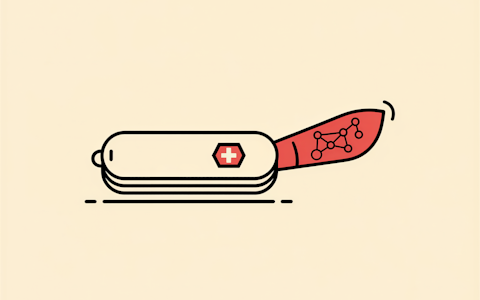From Islands to Communities

A short story about self-organization and belonging
We have been working in a self-organized way at smartive for around seven years. During this time, we have created roles, introduced decision-making processes - and abolished management. A courageous step at the time, based on the conviction that people take responsibility if they are given space. We believed, and still believe today, that trust is more effective than control.
What we did back then, with about thirteen people, not have made: Form teams.
We simply carried out our dailies with the whole company. One company, one team, so to speak.
It was lively, transparent and almost utopian. But also fragile. Because without boundaries, there was no functional differentiation, no stability.
Two years later, with around eighteen people, we realized: Our planning became more and more complicated. We had to schedule each person individually. A nightmare for project management and sales. So we needed teams.
We drew lines with a felt-tip pen around the people who often worked together anyway. And - tada! 🎉 - we had teams.
But the word "team" felt too rigid, too final. We wanted flexibility, not hierarchy.
This is how the Islands. A light, playful metaphor that suited us well. On an island, you can sometimes swim away (or be washed ashore). The islands were loose groupings. No special rights, no fixed boundaries. And that worked surprisingly well. It was fluid, flexible, organic. Just like our self-organized culture.
A few years later, we were 28 people. Two lockdowns had passed, two locations had been added. And suddenly not everyone was sitting together anymore. On top of that: The economic situation became tighter. Some had less work and felt isolated.
Experienced developers jumped from island to island to fill bottlenecks. Efficient in the short term, grueling in the long term. We were agile, yes. But somehow no longer connected.
In retrospect, a central organizing principle (according to Sparrer & Varga von Kibéd) was violated here: the Right to belong. In every living organization, every person needs a place where they belong. Even when they are not doing anything. If this principle is missing, the system loses energy, orientation and trust. This is exactly what happened to us.
So we changed the structure. And every relaunch also needs a rebranding. So:
Islands became Communities. 🥁
This was not a simple rebranding, but a genuine realignment: away from functional grouping and towards social anchoring. Today:
- The community is your social home.
- It is self-organized and makes decisions independently.
- It is guided by leadership principles and elects a delegate to coordinate with other communities.
- It includes all the roles required for projects.
- It is economically autonomous.
We have deleted the last point, financial responsibility. We're just not Buurtzorg (yet). 😄 The focus is clearly on the first principle: the community is your home, your sounding board, your safety net.
With the Communities, we have gone one step further. For us today, structures are less about control and more about Self-management and a sense of purpose.
When I look back on our development, I see three phases:
- Integration (One team): high coherence, little differentiation.
- Differentiation (islands): a lot of mobility, but social fragmentation.
- Re-integration (communities): Belonging on the basis of self-organization.
This movement is not a mistake, but the natural rhythm of a living organization: the constant balancing of autonomy and connectedness. The community structure creates spaces for both: self-reference, because communities control their own topics, roles and decisions, and external reference, because they are connected to each other via delegates.
Like autonomous cells in a larger organism.
Self-organization is not a state that can be achieved. It is an ongoing negotiation between structure and autonomy. Our islands were a necessary intermediate step. They enabled mobility, but took away belonging. Our communities bring back belonging without losing self-organization.
Perhaps that is precisely the core of systemic thinking in organizations: Not to find the "right" structure, but to constantly find out which order is currently working and which is no longer working.
Incidentally, these thoughts also accompanied me in my CAS in "Change Management, Organizational Development & Consulting". There I realized once again how much theory and practice mirror each other: Organizations are not machines that you adjust, but living systems that learn to understand themselves.
We don't know whether the communities will last forever. Maybe we'll need something new again in three years' time. But that's exactly the point: structures are not there to last forever. They are tools to make collaboration now possible.
As long as we remain curious and are prepared to question things, we will stay alive. As an organization and as people.
«"Systems are alive as long as they remain in motion and their movements are recognized."»

Written by
Robert Vogt





